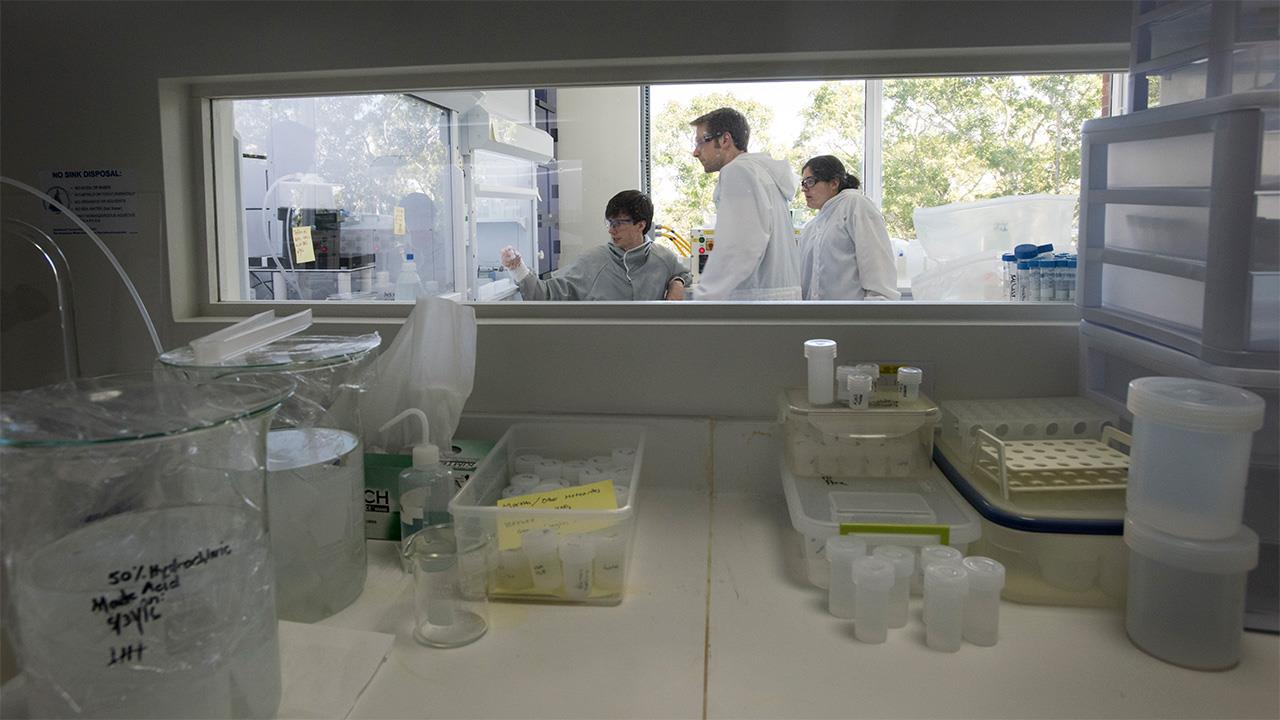2016 Research Highlights
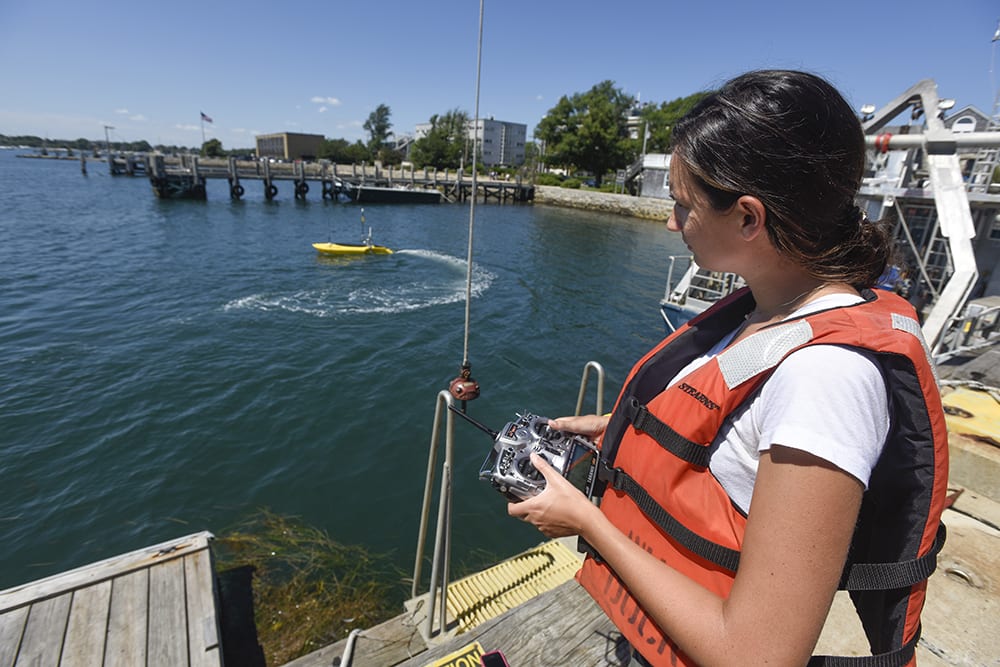
Measuring Greenhouse Gases with the JetYak
Rebecca Sugrue, Massachusetts Institute of Technology
Last summer, I had the privilege to work with Dr. Anna Michel and Dr. David Nicholson to construct an autonomous greenhouse gas sensing device, which employed a JetYak (a remote-controlled kayak designed by WHOI engineers) and gas sensors that measured dissolved methane and carbon dioxide gas in water. As a Summer Student Fellow working in both the Marine Chemistry and Geochemistry and the Applied Ocean Physics and Engineering departments, I was able to utilize both engineering and chemical analytical skills to create a functioning and accurate device.
The purpose of this project was based on the important need for real-time measurements and spatial mapping of greenhouse gases in water bodies. It is critical to understand the patterns of gases such as methane and carbon dioxide because it can offer insights into the impacts of societal and natural changes to areas surrounding water bodies. In the dissolved gas extraction unit system, a water sample is run through a 5-micron filter to an equilibrating membrane with a clean sweep gas. The dissolved gas is then transported to the analyzer where it is measured with a compact laser spectrometer. After multiple calibration experiments, I was able to determine the ideal setting which avoided leak issues and optimized concentration extraction. At those parameters, the system was able to reach 80% equilibration with the dissolved gases. The autonomous system functions to allow scientific observations to new unexplored or difficult regions with on-shore control and minimal impact on the natural ecosystem. It was extremely rewarding to create something from start to finish in the time that I spent at WHOI.
While working on the device, I helped to streamline data collection of multiple sensors aboard the vehicle by utilizing a Raspberry Pi (mini-computer). With the assistance of my advisors, I was able to develop my skills as a programmer with the use of Python and, ultimately, created a system that allowed for real-time read out of the data collected from the oxygen optode, dissolved gas extractor, gas analyzer, and weather station from the Raspberry Pi to the on-shore computer.
This project introduced me to the field of ocean and water studies by exploring a new area of research focused on understanding the air-water exchange system in rivers, lakes, and oceans. My time at WHOI taught me how to become a better researcher, engineer, and collaborator. I am very grateful for this opportunity and excited to learn how my work contributed to the progress of this important project.
Tracing Barium Isotopes
Ben Geyman, Bowdoin College
While barium isn’t the first element that comes to mind when we think about ocean nutrient cycles, its distribution exhibits a puzzling relationship with those of major nutrients such as silicon. Unlike silicon, barium is preserved in the calcium carbonate skeletons of corals and other marine organisms, and so it’s an appealing ‘proxy’ (a tracer that substitutes for the true variable of interest) for reconstructing biological productivity in the past oceans.
This summer I had the opportunity to work with Dr. Tristan Horner in the NIRVANA Labs at WHOI. Lab members work on wide ranging topics spanning the entire history of Earth: from the formation of continental crust billions of years ago, to climate changes during the last glacial cycle. What do all these topics have in common? All can be investigated using isotopes. Isotopes record biological and geochemical processes via the fractionation of light and heavy isotopes between two pools of an element. This summer Tristan and I were interested in using stable barium isotopes in seawater to understand the mechanisms driving barium distributions in the North Pacific Ocean and how these were recorded into the calcium carbonate skeletons of deep-sea corals.
Many processes impact ocean distributions of barium. Near coasts, rivers spill dissolved barium weathered from the continents into the ocean; near the ocean surface, barite crystals form inside aggregates of decomposing plankton, only to dissolve as they sink; and in the deepest basins of the ocean, physical circulation mixes water masses containing varying quantities of barium around globe. All of these processes can be disentangled by looking at the isotopic ‘signature’ of dissolved barium in the water. I deconstructed this complicated cycle by looking at how the concentration and isotopic composition of barium varies with depth in the North Pacific, which required isolating barium from seawater in the cleanest of clean labs. It would only take a tiny speck of dust or lint to contaminate a sample for Ba. The Ba concentration of surface seawater—a mere 6 nanograms per gram—is equivalent to a teaspoon of chlorine (15 mL) in an Olympic-size swimming pool (2.5 million liters). Before entering the lab, we suited up in head-to-toe gowns, glasses, and clogs (very stylish). Then we walked through a series of positive-pressure rooms designed to blow out dust and other potential contaminants.
Once we had the barium isolated, we ran samples on an instrument called a “multi-collector inductively coupled plasma mass spectrometer,” or MC-ICP-MS for short (or simply, ‘The Neptune’). The Neptune, which looks a lot like a Zamboni, is a million-dollar miracle of physics that I still don’t understand. The Neptune produced a set of isotope and concentration data for the Pacific seawater samples that we could compare to values from other parts of the ocean. Taken together, our data led us to the conclusion that global-scale mixing is likely more important for setting deep Pacific barium concentrations than vertical cycling originating at the surface. This finding is important because it impacts the interpretation of barium-based proxy records, and it makes a compelling case for the utility of isotope measurements in this work.
After work there was always time to run, swim, bike, and cook with others at the dorm. Students got together every week to watch Jojo consistently pick the worst suitors on the Bachelorette, and later we gathered to watch the presidential conventions and the Olympics. I also played for the Chemistry department softball team, which was a great way to meet people in a relaxed and non-competitive environment.
Overall, I am incredibly thankful to have had to opportunity to work and study at WHOI this summer. I was continually inspired by the science occurring all around me, and by my amazing peers in the SSF and PEP programs. With Tristan’s support, I became proficient working in the Lab, and I gained a much deeper knowledge of how isotopes can help illuminate environmental processes. Luckily, my project didn’t end when I left WHOI, and I’ve been able to continue thinking about barium as I prepare to present our work at the AGU Fall meeting (a convention of almost 25,000 geoscientists) in San Francisco this December.
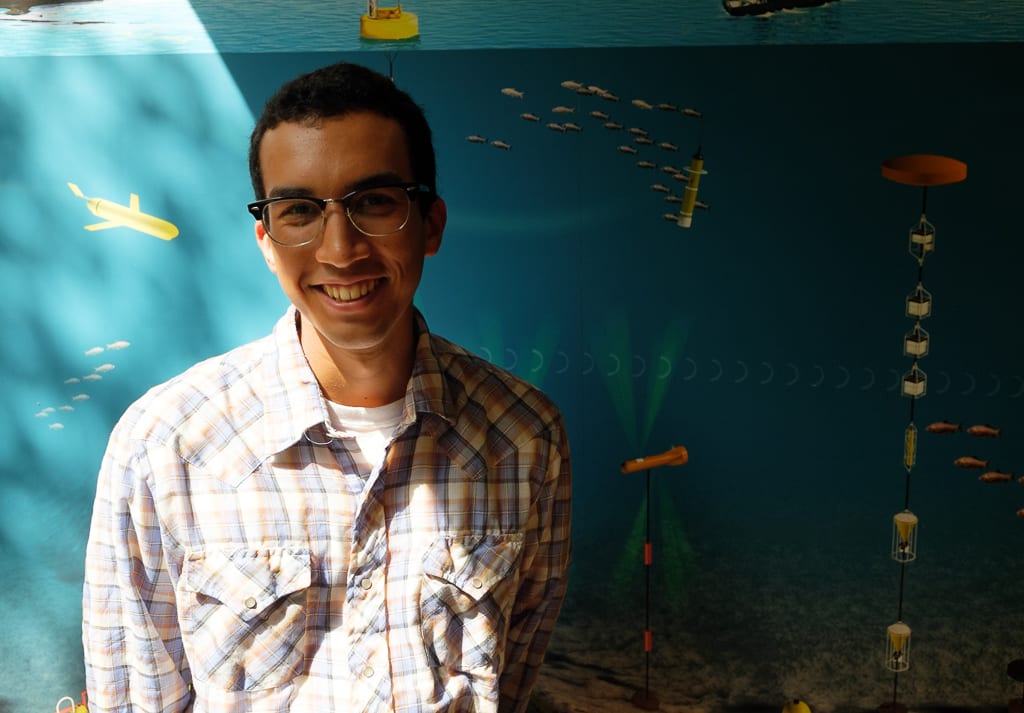
Exchange of Water Masses at the Shelf Break
Jacob Partida, Humboldt State University
Over the last couple of years, the Coastal Pioneer Array has been stationed offshore of New England in the continental shelf-break region. The shelf-break is where the sea floor begins to suddenly drop down many hundreds of meters towards the abyssal plain of the Atlantic Ocean. The Pioneer Array, one component of the Ocean Observatories Initiative that is deployed and maintained by WHOI, consists of a wide variety of oceanographic instruments which continuously measure different physical and chemical properties of the water column. These measurements, including those of temperature, salinity, and water velocity, reveal many complex stories that have multi-disciplinary implications for the local marine environment. This is especially true in the shelf-break region where a boundary often exists between two water masses with vastly different characteristics. Near the coast, water is cooler and less saline than offshore water associated with the Gulf Stream, the western boundary current of the Atlantic. However, these waters can be exchanged in an assortment of phenomenon such as eddies ("warm-core rings") or wind-driven surface flows. Fortunately, the Pioneer Array was placed in an optimal location to observe these exchanges, collecting valuable data which can help oceanographers to understand and explain the mechanisms at work and the important consequences of these natural processes.
This past summer, I worked with Dr. Gordon Zhang in the Applied Ocean Physics & Engineering department to find and closely examine two instances of cross-shelf water transport that the Pioneer Array captured in 2014 and 2015. One of these instances was a case of water moving down off of the shelf towards the open ocean. The second case was that of water moving from above the continental slope onto the shelf. What we found was that the transport of these water masses was significant enough in magnitude to be comparable to other known exchange processes in the system. Remarkably, without data collected by the instruments in the Pioneer Array, there would be no actual indication that these subsurface exchanges had occurred! Thus, one important lesson that I have learned this summer is that the ocean continues to surprise us, and we still have much to discover – even within the small amount of observational data available to us today.
During my time at WHOI, not only was I given the opportunity to research an aspect of the ocean that I find incredibly interesting, but I was also able to meet and talk with many amazing scientists, sit in on captivating seminars, make lasting friendships with other students, join a folk-music group, and enjoy all that summer has to offer on the Cape (i.e. riding the tides out of the marsh inlet at Black Beach and night-swimming in Oyster Pond!). Woods Hole, and the folks I met while there, will always have a special place in my heart. This was an inspiring and enlightening experience, one that I will forever appreciate. To help demonstrate that the people at WHOI care about their summer student fellows, I’d like to acknowledge Gordon for teaching me so many useful skills and being an absolutely great mentor, and I’d also like to acknowledge the incredible people who run the SSF program for all of their valuable advice and thorough assistance.
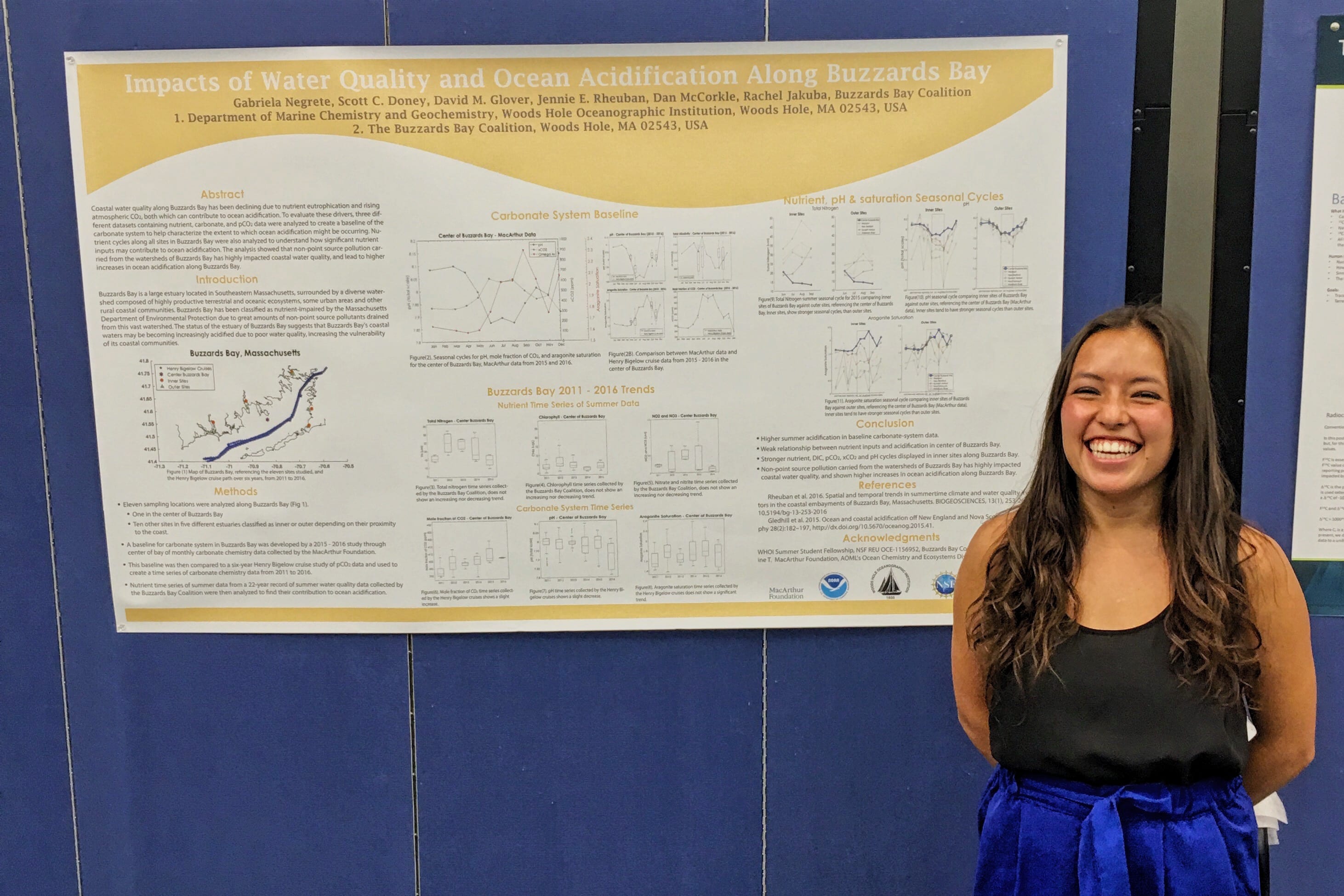
Water Quality and Ocean Acidification in Buzzards Bay
Gabriela Negrete, University of Wisconsin-Madison
This past summer, I had the opportunity to work with Dr. Scott Doney and Dr. David Glover on a Chemical Oceanography research project. Our goal was to determine the impacts of water quality and ocean acidification along Buzzards Bay, Massachusetts. It is of great importance to look at the impacts of water quality affecting our neighboring oceans, lakes, and rivers because of how heavily we depend on them for resources.
One of my favorite parts of this project was the opportunity to collaborate with the Buzzards Bay Coalition, allowing us to use their 20-year old record of nutrient quality data that volunteer scientists had collected during the summer. Volunteering in the scientific field is rare, and to be part of a community that both cares about the environment and are motivated by their interests to such an extent was astounding.
As part of this project, I was also able to collect carbonate data along five different sampling sites of Buzzards Bay to create a baseline of the carbonate system and understand the degree to which ocean acidification was changing. Using the 20 – year record of summer nutrient data, along with a six-year record of pCO2 data collected by NOAA and the ongoing 1.5-year record of carbonate data collected by WHOI scientists, we were able to investigate to what extent water quality was impacting ocean and coastal acidification along the aimed sampling locations of Buzzards Bay. The analysis showed that non-point source pollution carried from the watersheds of Buzzards Bay has highly impacted coastal water quality and has led to higher increases in ocean acidification along Buzzards Bay.
In addition to working on this fascinating research project, the Summer Student Fellowship at WHOI offered us incredible resources. Every week, researchers had the opportunity to attend lectures by scientists from all WHOI departments and become acquainted with their various research projects. We also had the chance to tour the Armstrong and participate in a one-day research cruise on the RV Tioga, where we learned techniques used in sea sampling. Unique additions to my experience this past summer at WHOI were making lifelong friendships with other Summer Student Fellows, being awarded Player of the Game in one of the chemistry softball games, being at walking distance from the beach at all times, and going for long runs along the Shining Sea Bikeway.
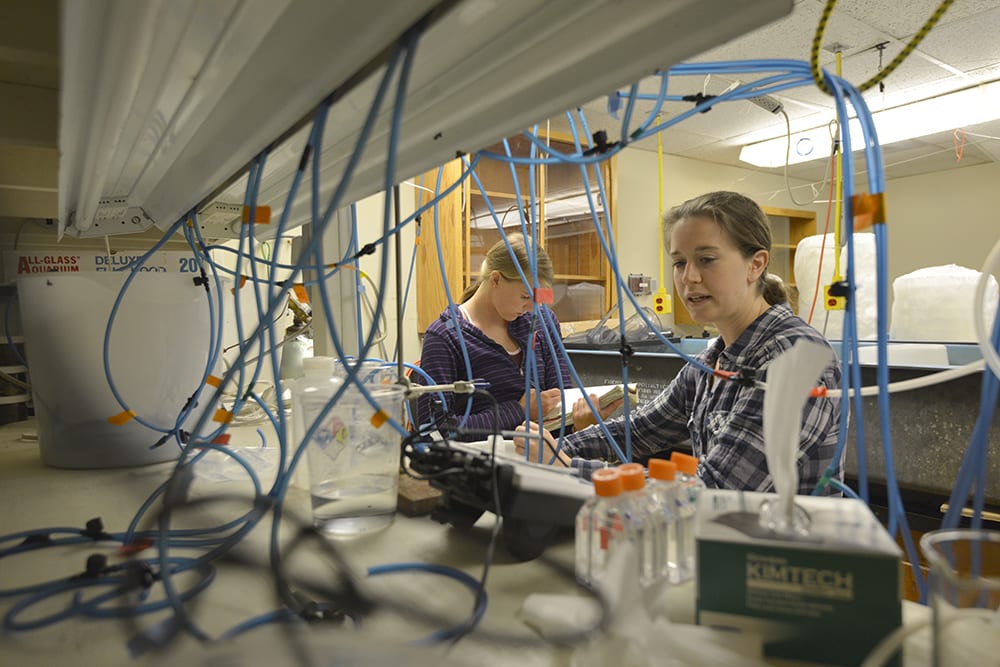
Estuarine Carbonate Chemistry
Colette Kelly, Barnard College
The oceans take up a significant proportion of anthropogenic carbon dioxide, and as a result, oceans have become more acidic. Upper-ocean pH has dropped by 0.1 units since the beginning of the industrial era, but the impact of rising atmospheric CO2 on estuarine chemistry is difficult to assess – biological processes and CO2 inputs from other sources (rivers, groundwater, sediments) result in daily and seasonal pH variation in estuaries much greater than those seen in the open ocean.
Last summer, I had the opportunity to with Dr. Daniel McCorkle to study the carbonate chemistry of Waquoit Bay, a National Estuarine Research Reserve on the southern shore of Cape Cod. My project focused on quantifying the drivers of carbonate chemistry in the Bay, based on six years of carbonate chemistry data collected by Dr. McCorkle’s lab previous to my time at WHOI.
Because of its status as a research reserve, there is a wealth of data available on Waquoit Bay in addition to our carbonate chemistry dataset, including hydrographic (temperature and salinity), meteorological (precipitation, sunlight, etc.), and sea level data. I combined the information from these datasets to assess the representativeness of the carbonate chemistry data, and determine potential drivers of seasonal and interannual variability in the carbonate chemistry of the Bay. This research is now the subject of my senior undergraduate undergraduate thesis, for which I am building a simple model of the Bay in order to quantitatively assess the relative importance of the drivers that I identified last summer.
I found it an inspiring and exceptional experience to work with a community of scientists at the leading edge of their field. During my time at WHOI last summer, I had the opportunity to work and discuss with researchers in both my own department and others, including physical oceanography, biology, and at USGS, in order to further my understanding of my project and related processes. This community extended into department softball games and pickup soccer at lunch, which gave me the opportunity to get to know scientists, other students, and staff in way that would be impossible in a more dispersive environment.
I am incredibly grateful for the opportunity to work at WHOI last summer, and am looking forward to developing this project further throughout the year.
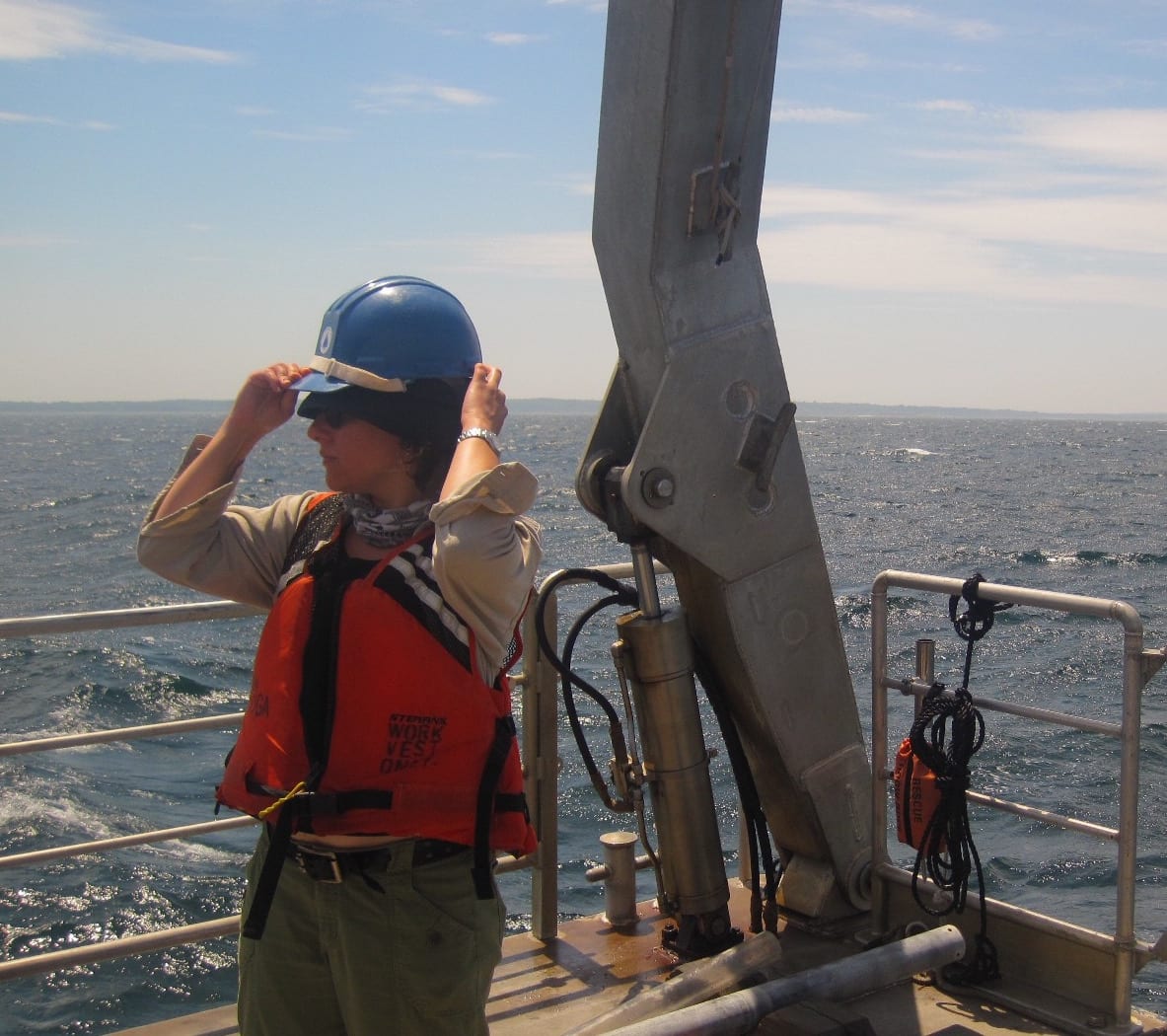
Submesoscale Dynamics in the Coastal Ocean
Kendra Lynn, Portland State University
The dynamics of coastal waters are complex, but it is important that we learn more about their movements. Mixing processes in these shallow regions of water contribute to the carbon cycle and transport nutrients that are necessary for biological productivity. For my summer research project I tried to better understand some of the drivers of small-scale variability off the southern coast of Nantucket Island, MA. I used high-resolution radar data to study submesoscale eddies and other interesting features in nearshore surface currents. To compare the water velocity gradient with sea surface temperatures from satellite imagery, wind stress magnitude, and local bathymetry, I calculated correlations for derivatives of the flow field such as shear, divergence and vorticity. By examining mean kinetic energy, eddy kinetic energy, and enstrophy during, before, and after wind-cessation events, I saw that wind does not appear to contribute substantially to the development of smaller-scale features in my study region. However, the energy spectrum phase-averaged over a daily tidal period gave support for the tides as an important mechanism driving submesoscale dynamics on the inner shelf south of Nantucket.
My advisors Anthony Kirincich and Amala Mahadevan were wonderful mentors, giving me freedom to discover and learn at my own pace, yet generous with their time, patient and attentive when I needed additional guidance and support. I felt welcome at WHOI and in the physical oceanography department. Every week there were many interesting lectures to attend on a variety of ocean science topics. This demonstrated to me the multidisciplinary nature of oceanography and the importance of collaboration across fields of study. Supplemental group discussions provided for summer student fellows and many other opportunities to interact with MIT/WHOI Joint Program students, postdocs and senior scientists alike made me feel like I was part of a community.
Over the course of the summer I was able to participate in numerous educational and enriching experiences. Seminars focused on informal science education and an ocean science themed dance workshop, exploring alternative methods of science communication, inspired new ideas for science outreach back home. A day spent aboard the R/V Tioga gave exposure to many advanced oceanographic sampling techniques and a sailing trip around Buzzards Bay added depth to my summer research experience. A chance to tour the newest research vessel Neil Armstrong and learn about Slocum Gliders at the Woods Hole Science Stroll provided an exciting glimpse into ocean research methods and instrumentation. Then, while in my free time reading a book about hydrothermal vents and deep-sea exploration by the first female pilot of Alvin, I was able to see the newest incarnation of the legendary submersible up close!
Spending the summer at WHOI was a dream come true. Countless spectacular sunsets, combing the beach collecting colorful stones, long bike rides on the scenic Shining Sea Bikeway, swimming in warm ocean waters sparkling with bioluminescent dinoflagellates, wading in a tidal river draining the Great Sippewissett marsh, and even my introduction to contra dancing at the Woods Hole Community Hall are all fond memories. I highly recommend taking advantage of the extraordinary opportunities that the WHOI summer student fellowship program has to offer.

